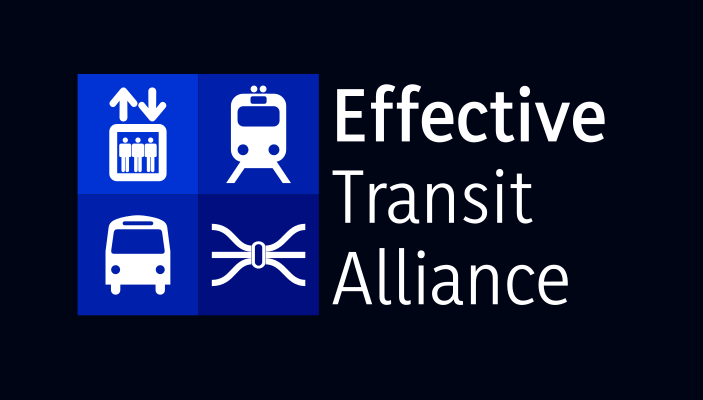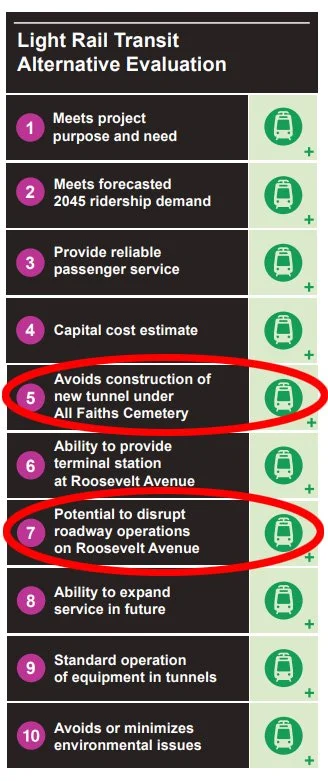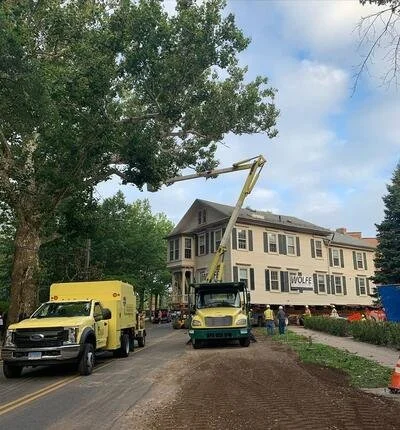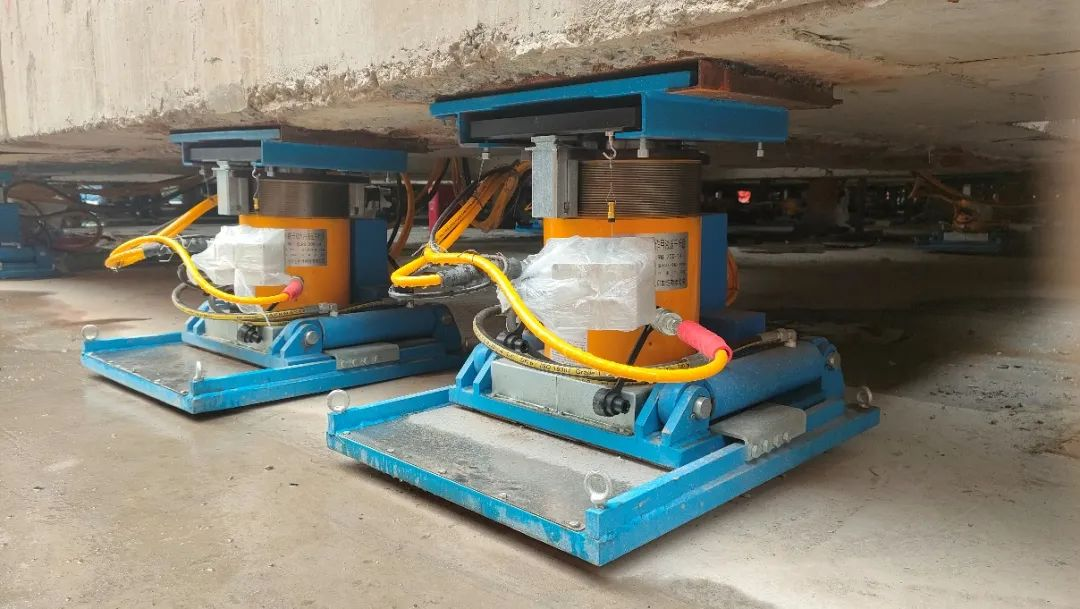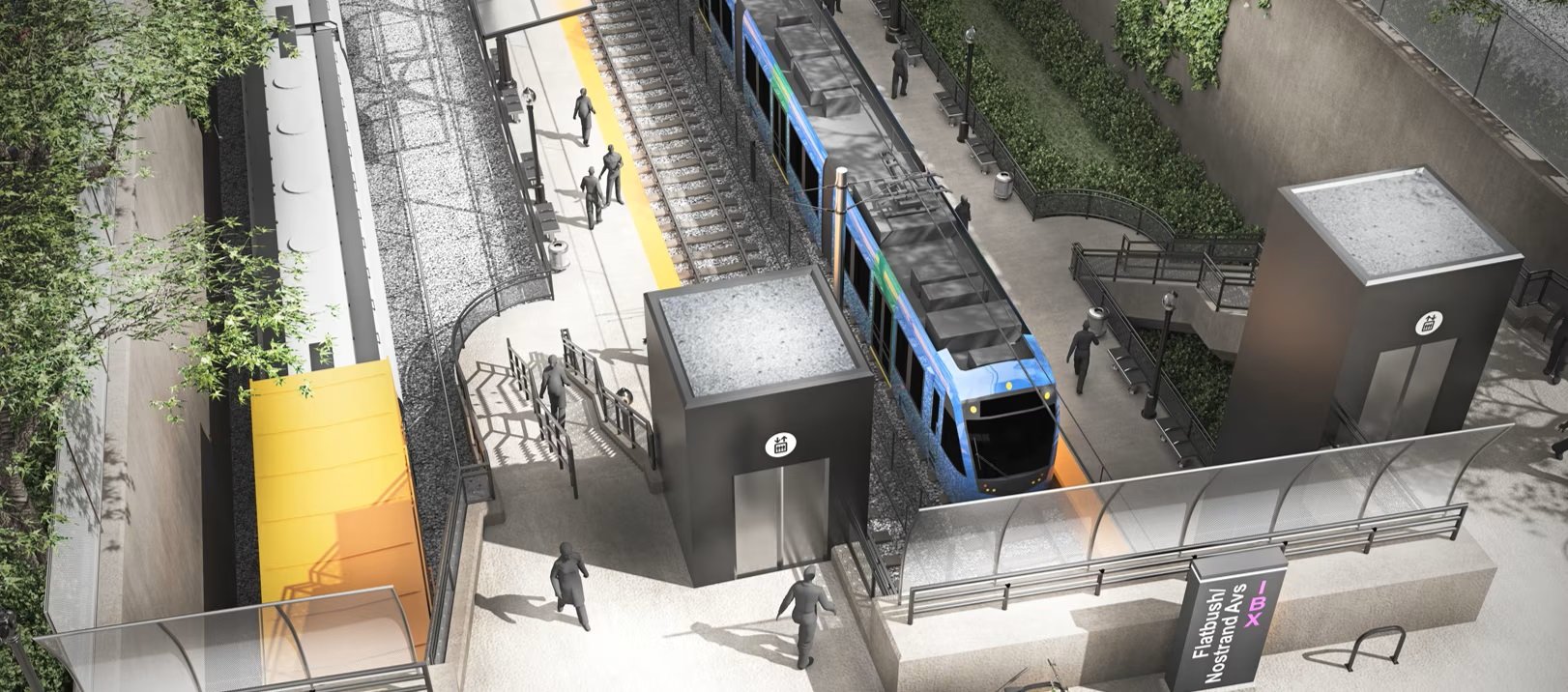
The Interborough Express: 515 Feet from Greatness
April 24, 2024
A short, 515 foot tunnel through All Faiths Cemetery is vital for the Interborough Express to live up to its potential (Diagram courtesy of Kara Fischer, underlying imagery courtesy of Google Maps).
Introduction
New York City's proposed Interborough Express (IBX) has the potential to be a transformative project. The project promises to dramatically improve cross-borough mobility by not only extending rail service to neighborhoods that currently have limited transit access, but also connecting together 16 distinct existing subway lines as well as the Long Island Rail Road. The Effective Transit Alliance applauds the initiative taken by Governor Hochul and the MTA to advance this long-needed project and complete it in the near term.
Unfortunately, the MTA's current proposal for the IBX would route trains along busy surface streets in Middle Village, Queens. The sole reason for this departure from an otherwise entirely grade-separated route is to avoid building a shallow, 515 ft-long tunnel under All Faiths Cemetery. Proceeding with this design would be shortsighted. This short tunnel would only slightly increase the cost of the project, as we detail below, and its benefits would be enormous. Street running dramatically harms the reliability of trains, slows their speed, and precludes any future attempt at automation. For the line to live up to its potential, it is critical that New York follow international best practices and avoid this unnecessary bit of street running.
What's more, the IBX must deliver fast, frequent, and reliable all-day service, on par with or exceeding that of the existing subway system. Current planning parameters, however, provide too little capacity for this new line, potentially fatally hamstringing its usefulness for riders. While the lack of the All Faiths tunnel is a major reason for this, other factors—including a plan to only run trains every 10 to 20 minutes outside of rush hour—also play a major role. The IBX will be a service where many riders will need to transfer twice: once to the new service, and once from it. As a result, a potential 20-minute wait would dramatically increase travel time, pushing riders back into buses, cars, and Manhattan-bound trains, if they travel at all.
The IBX is thankfully currently still in its early design and engineering phase, so that all the aforementioned problems have potentially positive solutions if the MTA takes action very soon. The Interborough Express can only live up to its transformative potential if it is built correctly the first time in its current proclaimed scope; the MTA should follow transit best practices and deliver a rapid transit line that can provide the capacity the corridor yearns for—which means constructing a tunnel under All Faiths Cemetery.
Transfers
Right now, current plans indicate that the IBX will not be built with in-system transfers to the existing subway system. If this mistake is corrected—as it should be—then the IBX would see substantially increased ridership. For example, while the IBX will pass Broadway Junction, which is the third-busiest station in Brooklyn serving 100,000 daily riders (including transfers) across 5 different subway lines, the MTA does not currently plan to build a station there.
Similarly, making transfers to buses, other subway lines, and LIRR as easy as possible is essential for the IBX’s success. But the MTA has not guaranteed that multiple transfers between bus, IBX, and subway lines will be free. Riders transferring to the subway will have to pass through fare gates again to reach subway lines, further worsening their experience. Building improved transfers will only make increasing the IBX’s limited current projected capacity all the more crucial. We will expand on the importance of convenient transfers in an upcoming report.
Ridership and Capacity
One of the primary reasons the IBX is such an attractive project is that it will largely follow the path of an existing, lightly-used freight line: the Bay Ridge Branch. This route is, with the exception of the aforementioned detour in Middle Village, entirely grade-separated, meaning that trains and street traffic never intersect. Grade-separated lines are ideal for transit, as they allow for high-capacity, high-reliability, and high-speed service regardless of traffic.
In contrast, the only direct connection between Queens and eastern and southern Brooklyn today is mixed-traffic buses. A 1989 paper by Ed Tennyson finds that even when the speeds of bus and urban rail along the same corridor are the same, rail can expect 34%–43% higher ridership due to a “clearly identifiable rail route; delineated stops that are often protected; more stable, safer, and more comfortable vehicles; freedom from fumes and excessive noise; and more generous vehicle dimensions.” Moreover, the speed of the IBX will greatly exceed that of today’s buses: the current light rail plan assumes an average speed of 22 mph, whereas the most closely parallel Brooklyn buses, the B6 Limited and B82 SBS, average 8 and 9 mph, respectively. By traveling faster and offering a higher-quality service, the IBX can therefore be expected to attract a high baseline ridership.
Light rail (LRT) as currently conceived—that is, with a portion of the route running on the street in Queens—is insufficient to handle these needs. Moreover, due to the tight curves that the on-street alignment would include, the IBX’s light rail vehicles (LRVs) will be limited to 3 cars and thus about 360 riders each. This is already not enough frequency and not enough per-vehicle capacity to meet the IBX’s predicted demand, even without accounting for surges.
Specifically, the LRT ridership at Brooklyn College is estimated by the MTA to be 1,287 riders carried in one direction during the peak 15 minutes[1] (and 1,382 riders if conventional rail were used). Even without other passengers, this will exceed the maximum capacity of a 360-person LRV running every 5 minutes: 1,080 passengers. As a result, under the current plan for the IBX, from day one, riders will have to let trains go by before one comes with enough space on it for them to board.
Even the peak 15 minutes might not be granular enough. The peak load point is estimated to be Brooklyn College, which has coordinated class start and end times, which will cause passenger surges on the last vehicle or two arriving before a morning class and on the first one or two departing after evening classes. Already, the B1 bus route has some peak-only buses scheduled for such ridership spikes between the Brighton Beach subway station and Kingsborough Community College.
Adding in-system transfers is likely to create similar surges, as passengers transfer from 10-car subway trains to IBX. And adding a Broadway Junction station would add hundreds of more riders[2] at the peak 15 minutes in the busiest sections of the line in eastern Brooklyn, further overloading already packed LRVs.
Because frequency is important, it often makes sense to run shorter trains more frequently, to avoid either wasted capacity or long waits. However, surges like at Brooklyn College, or at transfers from longer subway trains running every 10 minutes, would overload 360-passenger LRVs. Instead, it is likely better to run 4- or 5-car trains akin to subway cars—like those used on the JFK AirTrain or Vancouver SkyTrain, for instance—with a surge capacity of about 150 seated and standing passengers per 60-foot car.[3] NYC Transit itself already runs 300-foot trains on the G and the Staten Island Railway, and by removing street running, the IBX can run these types of longer, automated vehicles.
The IBX must be built with appropriate capacity for ridership surges, something that street running cannot accommodate. Building a new transit line that cannot even meet demand on day one is unacceptable, and future growth from transit-oriented development and improved connections to other transit lines will only strain the IBX further. This is why it is critical to build the IBX right, especially when the alternative is readily at hand.
Top: A map of the proposed IBX route, with the problematic street running section highlighted in red, and then an overview of the existing conditions, with the proposed street running segment highlighted in red.
Bottom: A diagram of the convoluted street running proposal. (All images from the MTA, edited by ETA).
The Problem with Street Running
Most of the problems mentioned above stem from a single issue: the current plan to run the IBX on the street through Middle Village, along Metropolitan Avenue, 69th Street, and 69th Place. Street running not only severely restricts capacity, it makes the line incredibly vulnerable to traffic delays—far more vulnerable than even the current crosstown bus lines. Instead, the clear alternative is to build a shallow tunnel under All Faiths Cemetery, something which, as we will demonstrate, can be done comparably inexpensively.
Even with dedicated lanes and signal priority, at-grade operations must contend with interference from cars, trucks, buses, and other traffic. Unlike buses, trains cannot reroute around gridlock, blocked intersections, or car crashes. Street running can make sense under certain conditions in certain locations. Hudson–Bergen Light Rail trains in Jersey City, for instance, share a lane of Essex Street with mixed traffic. While Essex Street is a lightly-trafficked road flanked by apartments, however, Metropolitan Avenue is a highly congested truck route, making delays inevitable. In fact, the MTA performed an analysis of potential street running on the IBX’s northern end as a way to connect to the Roosevelt Avenue subway station and found it infeasible. To our knowledge, no such analysis was conducted for the Metropolitan Avenue segment.
The MTA’s chosen methodology for evaluating at-grade operation predicts that, at best, Metropolitan Avenue traffic levels[4] warrant an engineering study likely culminating in a recommendation for traffic signal priority and dedicated lanes. The analysis framework is based on that used for the Foothill Gold Line in Los Angeles, which will have dedicated lanes like LA’s other light rail lines. To even begin to make street running live up to the demand predicted for the IBX would require light rail priority, parking removal, and separate lanes—all politically difficult asks that, even if all completed, will not match the speed and reliability of a short tunnel. As a result, any design that relies on them is politically risky—if not fatally flawed.
One of the MTA’s mistaken planning goals has been to avoid the construction of a tunnel through All Faiths Cemetery. Another goal was to avoid disruption on Roosevelt Ave, but not Metropolitan Ave. (Source: MTA, edited by ETA).
Tunnel Alternatives
The MTA’s justification for street running is to avoid digging a 515-foot-long tunnel under the All Faiths Cemetery, one which would parallel the existing freight tunnel, which was designed to eventually be built into a four-track structure. The Planning and Environmental Linkages (PEL) study for IBX, conducted by AECOM, did look at tunnels as part of the conventional rail alternative. The options included a shallow tunnel and a deep tunnel, but the conventional rail alternative included a full study of only the deep option since it avoids direct impact to the cemetery above. However, a deep tunnel would be much more expensive than a shallow one. While the shallow tunnel was said to have a risk of negatively impacting the cemetery, there are viable alternatives for shallow tunnels with less impact. Moreover, a new shallow tunnel can be built regardless of whether the IBX or relocated freight trains use it.
Shallow cut-and-cover tunneling, used to build most of the subway from 1900 to the 1980s, can be done cheaply. The cost of a cut-and-cover tunnel scales with the volume of earth excavated. At the unit costs of the 96th Street station on the Second Avenue Subway, which was built with cut-and-cover, an All Faiths Cemetery tunnel would cost $40 million; at Italian cut-and-cover unit costs, it would cost only $15 million. While cut-and-cover requires temporarily opening up the street, there are no residents or merchants along the relevant IBX segment save a single building bridging over the trench. Cut-and-cover is so much more cost-effective that cities that have bored tunnels underneath streets have also often used it through parkland to reduce costs; the planned expansion of Paris Métro Line 1 and the under-construction extension of Nuremberg U3 are two such examples.
Furthermore, while there may be impacts to the cemetery’s mausoleum from tunnel construction, unlike a tunnel, street running will require property takings where the IBX exits the cut onto Metropolitan Avenue and the building on the corner where it makes a very sharp turn onto 69th Street. On such tight curves, trains screech loudly, while they would make little noise passing straight through a tunnel. It is nonetheless true that the shallow cut-and-cover tunnel option will likely impact the cemetery since the new tunnel would pass under one corner of a mausoleum. Fortunately, there are six mitigating options:
Go deeper
The cut-and-cover or Sequential Excavation Method (SEM)[5] option could be deeper, perhaps enough to go underneath the foundations of the mausoleum. The PEL report assumes a maximum grade of 2.5%, but the 7 train climbs 4.6% grades in the Steinway Tunnel, and light rail lines in the United States routinely climb 7%. In fact, the same PEL report uses a grade of 3.72% for LRT when it re-enters the cut after going around the cemetery. With 4.6% grades, the tunnel could go 30 ft under the mausoleum,[6] whereas the PEL study assumes only 18 ft. The cost would be proportionately higher, but the mausoleum would be spared. The tunnel only goes for a short distance under it. Early cut-and-cover subway tunnels were mined under cross streets to preserve traffic flow, so mining a tunnel under the mausoleum that is otherwise dug by cut-and-cover should be possible. Most recently, the MTA used SEM for a 121 ft tunnel in Queens under Northern Boulevard and the Queens Boulevard Subway, as part of East Side Access. As this was done without long-term disturbance to the subway, the same technique could be used to preserve the mausoleum in place.
Share the tunnel
Freight trains currently go underneath the cemetery in a two-track tunnel, which opened in 1916, around the same time as the New York Connecting Railroad and Hell Gate Line. This is the only land-based route for freight into Long Island (the Port Authority runs a low-capacity rail ferry at the south end of IBX to New Jersey); any delays moving freight could cause a day-long delay getting freight on or off Long Island. A commuter rail option would straightforwardly be able to share the tunnel at any time there were free slots, but a subway or light rail one might not due to Federal Railroad Administration (FRA) rules, limiting time-sharing possibilities to overnight.
It’s also possible to set up the tunnel to be used by passenger trains as a normal double-track line during most of the day, but as two separate single-track lines during the night, one for passenger trains and one for freight trains; nighttime frequencies are low enough that a single pinch point of this length should not be hard to schedule.
Time-sharing, however, would add another constraint to freight between the mainland and Long Island that could further complicate operations that are already time-restricted to avoid interfering with commuter trains on Metro North and LIRR lines. Timesharing would also complicate maintenance scheduling.
Go east of the existing tunnel
Rail advocate John Pegram proposed that the IBX tunnel be built east of the existing freight tunnel rather than west of it. The mausoleum is west of the existing tunnel, but there is likely room for at least a single-track tunnel under access roads east of the current tunnel, avoiding impact to graves. The drawback of this option is that the existing trench is four tracks wide, but the unused space is to the west of the tracks that go into the tunnel. Thus, an eastern option would require widening the trench to the east by at least one track width, and public data is not available as to what is underground in the entirety of this area.
Build a stacked tunnel underneath the existing tunnel
Rather than build a parallel tunnel to the west or east, the new tunnel could be built underneath the existing tunnel. This would allow the existing tunnel’s arch to stay intact, and it wouldn’t go underneath the mausoleum. Either a stacked tunnel or parallel tunnel would require at least a partial closure of the existing tunnel used by freight trains during the construction process. The main drawback of this option is the potential need to shut down one or both tracks for an extended period of time.
Relocate remains in the mausoleum
As Ben Brachfeld writes in amNewYork, neither the MTA nor AECOM reached out to the cemetery to discuss the impact; the supervisor was not aware of the project at all. The mausoleum has about 500 crypts, of which half are in use; those could be moved to a mausoleum to be built elsewhere, with the bereaved families compensated. It appears that no impact is required to graves outside the mausoleum.
Alternatively, the remains could only be temporarily relocated while crews dig the new tunnel, and the building is fully or partially rebuilt. Newly excavated rapid transit lines commonly run into building piles along their routes despite design and engineering that aim to circumvent them. For example, the tunneled section of Wuhan Rail Transit Line 5 between Peng Liu Yang Station and Si Men Kou Station interfered with 4 overpass bridge pile foundations that the tunnel boring machine (TBM) could not just cut through. In response, crews mined an empty underground section to replace the pile support before the TBM passed through, ensuring the uninterrupted operation of the existing highway and enabling the TBM to dig an entire section of subway line. An Enki article discusses the technique in further detail.
An aerial schematic of the section between Pen Liu Yang and Si Men Kou stations. The tunnel sections where bridge pile modifications were required is colored dark purple. (Source: Press Release)
Site photos showing the process of pile removal within the mined tunnel that the TBM would later pass through (Source: Press Release).
Finished reinforced and partially severed bridge pilings (Source: Press Release).
Jack and relocate the mausoleum
Relocating large structures has ample precedent. In New Haven, an 1807 house that Yale University owns was recently moved. Decades ago, crews relocated a telephone exchange in Evansville, Indiana. The Zhang Yuan Urban Renewal Project in Shanghai required jacking and moving a series of historically significant buildings to a temporary site location to free up construction space and then returning the building complex back to the original site after construction of underground transfer passages was completed.
An 1807 house in New Haven moved in 2020 (Source: It’s Your Yale).
Building jacks installed to move historically significant buildings in Shanghai (Source: Press Release).
Benefits of a Shallow Tunnel
No matter how it is built, a shallow tunnel through All Faiths Cemetery would be very short and not require the construction of any underground stations. In contrast, the deep tunnel advanced in the PEL report requires long approaches that would force the proposed Metropolitan Avenue station to be built underground at a much higher cost.
With all stations built at-grade or above-ground, cut-and-cover options would cost in the low- to mid-eight figures, less than 1% of the total $5.5 billion projected budget. This, in turn, would speed up trip times by about 10% and improve reliability and capacity, a large benefit from a very short tunnel without residents to be disturbed.
Conclusion
Making the IBX as effective as possible for as many people as possible is essential for improving mobility in Queens, Brooklyn, and New York City as a whole. This means avoiding street running, and building a short tunnel through All Faiths Cemetery. Building a section of street running to avoid building a short tunnel through the cemetery is not worth the severe degradation in service quality and capacity it would impose. The MTA should instead work collaboratively with the leadership of All Faiths Cemetery, as the latter already expressed willingness to do, to accommodate a tunnel in an achievable, respectful manner.
If the IBX is built with street running, it will be chronically delayed and overcrowded from day one. Even when there are no delays, riders will have to let trains go by before one comes with enough space on it and then be squeezed into a jam-packed train. But if the IBX is entirely grade-separated, it could run at far higher frequencies, use longer and larger trains, and potentially even be automated. Overall, capacity could be increased by up to 17-fold[7] to support further growth through better transfers, improved buses and transit-oriented development. Plus, without the slow, delay-prone street running segment, 4–6 minutes would be shaved off of the 39-minute runtime,[8] running 10%–15% faster overall. This is the service level that Queens and Brooklyn need.
Once built and operational, the IBX’s infrastructure will be difficult to modify; it is critical to make the right design choices now. The benefits of complete grade separation are massive. To limit the line to simply avoid building a short tunnel is the epitome of penny-wise, pound-foolish. The IBX should be built with full grade separation from day one.
Footnotes
The PEL report estimated crowding by measuring ridership in the peak 15 minute period, the 15 minutes with the most number of riders on the IBX.
The similarly busy transfer station of Roosevelt Av–Jackson Heights is predicted to have 601 riders in that peak 15 minute period.
The explicit assumption is 2.7 square feet of standing space per standee, or 4 standees per square meter, a metric used in capacity planning in Europe and China. This represents slightly lower peak crowding than that on the L or 2/3 before the pandemic, or the 4/5 before the opening of the Second Avenue Subway.
As in the MTA’s own analysis, we applied a 1.054% annual traffic growth rate to 2019 traffic.
Sequential Excavation Method, or New Austrian Tunneling Method, is the tunneling method chosen for the shallow tunnel in the PEL report.
18 ft + (515 ft / 2) * 4.6% = 29.85 ft
3-car, 360-person Kinki Sharyo LRVs every 5 minutes vs. 10-car, 2400-person R211s every 2 minutes
The PEL report did not actually consider the delay of street running for the LRT alternative, so it would likely be longer than 39 minutes.
